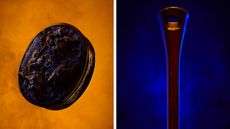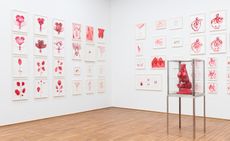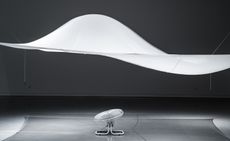Jeff Koons’ Technicolor takeover of the Whitney Museum

Giddiness is rarely associated with Brutalist architecture, but it might well be the sensation by which the Whitney Museum's Marcel Breuer-designed home is remembered - thanks to Jeff Koons. The former Wallpaper* guest editor and artist's vast retrospective, which opens to the public on Friday, occupies nearly every available floor, wall, and nook of the museum (approximately 2,500 sq m) and is an exuberant farewell to the 1966 Breuer Building as the Whitney prepares to move into its new space in downtown New York, designed by Renzo Piano. 'We wanted to say goodbye with a flourish,' says Adam Weinberg, director of the Whitney.
Born in Pennsylvania, Koons, 59, has lived and worked in Manhattan since 1976, but this marks his first large-scale museum presentation in New York. The challenge for the Whitney was to mount a show that would encourage visitors to look anew at the work of a celebrity artist who has simultaneously exploded and been reduced to a global cultural shorthand of stunning auction prices and gleaming, chromium steel balloon animals. ('Jeff, what are you wearing?' implored one attendee at Tuesday's press preview. Answer: Dior Homme.)
'We're at a distance now that we can assess some of these kind of mythic objects with a different perspective,' says Whitney curator Scott Rothkopf, who has spent the last five years organising the retrospective. 'I think it will be very surprising for people to see some of Jeff's most famous icons, like the Balloon Dog or Michael Jackson and Bubbles and the Rabbit, in the context of the works from which they emerged and within these series that are extremely complex in their subject matter and in their ways of making.'
Organised chronologically, the show traces Koons' multifaceted output from 1978 to works that were completed last week. New connections within and among the delineated series - such as 'Inflatables', 'Luxury & Degradation', and 'Easyfun' - click into place as one moves from room to room. A very early assemblage of coloured sponges scattered among mirrors reveals itself as a precursor to the bright and obsessively engineered forms that came decades later. The 'Banality' sculptures take a turn for the sinister when viewed together and in the round, a recurring moustache motif evokes Dali and Duchamp.
The restrospective's masterstroke is its ascension from past to present through the three main floors, so that the scale of the work grows with the building's floor plate. The drama gradually builds to a full swing celebration on the fourth floor. There are balloons, including a giant pink one affixed to the wall in an Anish Kapoor-goes-to-the-party-store moment; cake (a painted slice that stands about three metres tall); and 'Play-Doh' (2014), a massive mound of multicoloured modelling clay that Koons has been working for more than two decades to realise, eventually turning to 27 pieces of interlocking aluminium to replicate what he describes as 'a very joyous, very pop material'.
And Koons is not done yet. 'I believe completely in the work that we have here, and I hope that other people can find meaning in it, but for myself I really feel that it's about the future,' says the artist, speaking with characteristic ebullience. 'I believe that I have another at least three decades - I hope even more - to create art, and truly to be able to exercise the freedom that we all have as individuals to do exactly what we want.'

'Tulips', 1995-98. The former Wallpaper* guest editor's vast show, which opens to the public on Friday, occupies nearly every available floor, wall, and nook of the museum.

'Gazing Ball (Mailbox)', 2013. Organised chronologically, the show traces Koons' multifaceted output from 1978 to works that were completed last week.

'Loopy', 1999. Inspired in part by Pablo Picasso’s remark, 'When I was a child I could draw like Raphael, but it took me a lifetime to draw like a child', Loopy and other paintings from the Easyfun series aim to recapture the innocent spirit of childhood.

'Hanging Heart (Violet/Gold)', 1994-2006. The restrospective's masterstroke is its ascension from past to present through the main floors, with the drama gradually building to a full swing celebration

Balloon works include 'Moon (Light Pink)', 1995-2000, a giant pink one affixed to a wall, and...

...and 'Cake', 1995-1997, a painted slice that stands about three metres tall.

Koons has hinted that one of his most recognisable works, 'Balloon Dog (Yellow)', 1994- 2000, has darker themes, comparing its form to a Trojan horse, the giant wooden gift that the Greeks bestowed on their Trojan enemies, while Greek soldiers lurked inside

'Metallic Venus', 2010-12.

'Large Vase of Flowers', 1991. The challenge for the Whitney was to mount a show that would encourage visitors to look anew at the work of a celebrity artist.

'Inflatable Flowers', 1979. Collection of Norman and Norah Stone.

'Kangaroo (red)', 1999. Courtesy of Whitney Museum of American Art. Private collection; courtesy Sonnabend Gallery, New York.

'Split-Rocker (Orange/Red)', 1999. Collection of BZ and Michael Schwartz.

Outside of the museum, an iteration of Koon’s 'Split-Rocker' from 2000 has been installed at New York’s Rockefeller Center, where it will be on view until 12 September. The monumental sculpture-cum-topiary, presented by Gagosian Gallery in collaboration with the Public Art Fund and real estate company Tishman Speyer, is studded with thousands of flowering plants that are watered through an internal irrigation system. © Jeff Koons. Courtesy of Gagosian Gallery.
ADDRESS
Whitney Museum
945 Madison Avenue
New York, NY 10021
Wallpaper* Newsletter
Receive our daily digest of inspiration, escapism and design stories from around the world direct to your inbox.
Stephanie Murg is a writer and editor based in New York who has contributed to Wallpaper* since 2011. She is the co-author of Pradasphere (Abrams Books), and her writing about art, architecture, and other forms of material culture has also appeared in publications such as Flash Art, ARTnews, Vogue Italia, Smithsonian, Metropolis, and The Architect’s Newspaper. A graduate of Harvard, Stephanie has lectured on the history of art and design at institutions including New York’s School of Visual Arts and the Institute of Contemporary Art in Boston.
-
 Three new coffee makers for a contemporary brew, from a casual cup to a full-on branded espresso
Three new coffee makers for a contemporary brew, from a casual cup to a full-on branded espressoThree new coffee makers, from AeroPress, Jura and Porsche x La Marzocco, range from the defiantly manual to the bells and whistles of a traditional countertop espresso machine
By Jonathan Bell Published
-
 Don't miss Luxembourg's retro-futuristic lab pavilion in Venice
Don't miss Luxembourg's retro-futuristic lab pavilion in VeniceAs the Venice Biennale enters its last few weeks, catch 'A Comparative Dialogue Act' at the Luxembourg Pavilion
By Amah-Rose Abrams Published
-
 A Berlin park atop an office building offers a new model of urban landscaping
A Berlin park atop an office building offers a new model of urban landscapingA Berlin park and office space by Grüntuch Ernst Architeken offer a symbiotic relationship between urban design and green living materials
By Michael Webb Published
-
 Jeff Koons’ art has landed on the moon with Odysseus
Jeff Koons’ art has landed on the moon with Odysseus‘Jeff Koons: Moon Phases’ is on the Odysseus lunar lander and due to make a giant NFT leap for the artist, having landed on Thursday 22 February 2024
By James Gurney Published
-
 Royal College of Physicians Museum presents its archives in a glowing new light
Royal College of Physicians Museum presents its archives in a glowing new lightLondon photography exhibition ‘Unfamiliar’, at the Royal College of Physicians Museum (23 January – 28 July 2023), presents clinical tools as you’ve never seen them before
By Martha Elliott Published
-
 Museum of Sex to open Miami outpost in spring 2023
Museum of Sex to open Miami outpost in spring 2023The Museum of Sex will expand with a new Miami outpost in spring 2023, housed in a former warehouse reimagined by Snøhetta and inaugurated with an exhibition by Hajime Sorayama
By Harriet Lloyd-Smith Published
-
 Remembering artist Ashley Bickerton (1959 – 2022)
Remembering artist Ashley Bickerton (1959 – 2022)Ashley Bickerton, known for his subversive, conceptual takes on consumerism, has died aged 63. We explore his life, work, and extraordinary studio, photographed in 2017 when Wallpaper* US director Michael Reynolds and Stephen Kent Johnson visited the artist
By Martha Elliott Last updated
-
 Jenny Holzer curates Louise Bourgeois: ‘She was infinite’
Jenny Holzer curates Louise Bourgeois: ‘She was infinite’The inimitable work of Louise Bourgeois is seen through the eyes of Jenny Holzer in this potent meeting of minds at Kunstmuseum Basel
By Amah-Rose Abrams Published
-
 ‘A Show About Nothing’: group exhibition in Hangzhou celebrates emptiness
‘A Show About Nothing’: group exhibition in Hangzhou celebrates emptinessThe inaugural exhibition at new Hangzhou cultural centre By Art Matters explores ‘nothingness’ through 30 local and international artists, including Maurizio Cattelan, Ghislaine Leung, Hiroshi Sugimoto, Liu Guoqiang and Yoko Ono
By Yoko Choy Last updated
-
 Three days in Doha: art, sport, desert, heat
Three days in Doha: art, sport, desert, heatIn our three-day Doha diary, we record the fruits of Qatar’s cultural transformation, which involved Jeff Koons, a glass palace of books, and a desert sunset on Richard Serra
By Harriet Lloyd-Smith Last updated
-
 At home with Jeff Koons
At home with Jeff KoonsWe visit Jeff Koons (via Zoom) in his New York City studio to discuss transcendence, the Renaissance, and his show, ‘Shine’ at Palazzo Strozzi, Florence
By Harriet Lloyd-Smith Published